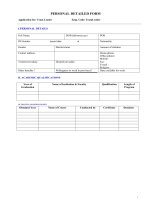Tài liệu Personal Goal Setting - Planning to Live Your Life Your Way pptx
Bạn đang xem bản rút gọn của tài liệu. Xem và tải ngay bản đầy đủ của tài liệu tại đây (143.15 KB, 5 trang )
Personal Goal Setting - Planning to Live Your Life Your Way
How to Use Tool:
Goal setting is a formal process for personal planning. By setting goals on a routine basis you decide
what you want to achieve, and then step-by-step move towards the achievement of these goals. The
process of setting goals and targets allows you to choose where you want to go in life. By knowing
precisely what you want to achieve, you know what you have to concentrate on to do it. You also know
what is merely a distraction.
Goal setting is a standard technique used by top-level athletes, business-people and achievers in all
fields. It gives you long-term vision and short-term motivation. It focuses your acquisition of knowledge
and helps you to organize your resources.
By setting sharp, clearly defined goals, you can measure and take pride in the achievement of those
goals. You can see forward progress in what might previously have seemed a long pointless grind. By
setting goals, you will also raise your self-confidence, as you recognize your ability and competence in
achieving the goals that you have set. The process of achieving goals and seeing this achievement gives
you confidence that you will be able to achieve higher and more difficult goals.
Goals are set on a number of different levels: firstly you decide what you want to do with your life and
what large-scale goals you want to achieve. Then you break these down into the smaller and smaller
targets that you must hit so that you reach your lifetime goals. Finally, once you have your plan, you start
working towards achieving it.
Starting to Set Personal Goals
This section explains how to set personal goals. It starts with your lifetime goals, and then works through
a series of lower level plans culminating in a daily to-do list. By setting up this structure of plans you can
break even the biggest life goal down into a number of small tasks that you need to do each day to reach
the lifetime goals.
Your Lifetime Goals
The first step in setting personal goals is to consider what you want to achieve in your lifetime - setting
Lifetime goals gives you the overall perspective that shapes all other aspects of your decision making.
To give a broad, balanced coverage of all important areas in your life, try to set goals in some or all of the
following categories:
•
Artistic:
Do you want to achieve any artistic goals? If so, what?
•
Attitude:
Is any part of your mindset holding you back? Is there any part of the way that you behave that
upsets you? If so, set goals to improve or cure the problem.
•
Career:
What level do you want to reach in your career?
•
Education:
Is there any knowledge you want to acquire in particular? What information and skills will you
need to achieve other goals?
•
Family:
Do you want to be a parent? If so, how are you going to be a good parent? How do you want to
be seen by a partner or by members of your extended family?
•
Financial:
How much do you want to earn by what stage?
•
Physical:
Are there any athletic goals you want to achieve, or do you want good health deep into old age?
What steps are you going to take to achieve this?
•
Pleasure:
How do you want to enjoy yourself? - you should ensure that some of your life is for you!
•
Public Service:
Do you want to make the world a better place by your existence? If so, how?
Once you have decided your goals in these categories, assign a priority to them from A to F. Then review
the goals and re-prioritize until you are satisfied that they reflect the shape of the life that you want to
lead. Also ensure that the goals that you have set are the goals that you want to achieve, not what your
parents, spouse, family, or employers want them to be.
How to Start to Achieve Your Lifetime Goals
Once you have set your lifetime goals, set a 25 year plan of smaller goals that you should complete if you
are to reach your lifetime plan. Then set a 5 year plan, 1 year plan, 6 month plan, and 1 month plan of
progressively smaller goals that you should reach to achieve your lifetime goals. Each of these should be
based on the previous plan.
Finally set a daily to-do list of things that you should do today to work towards your lifetime goals. At an
early stage these goals may be to read books and gather information on the achievement of your goals.
This will help you to improve the quality and realism of your goal-setting.
Finally review your plans, and make sure that they fit the way in which you want to live your life.
Staying on Course
Once you have decided your first set of plans, keep the process going by reviewing and updating your to-
do list on a daily basis. Periodically review the longer term plans, and modify them to reflect your
changing priorities and experience.
An easy way of doing this is to use the goal-setting software like
GoalPro5 on a daily basis - we review
GoalPro on the left-hand sidebar, alternatively you can download GoalPro from
Success Studios web
site. GoalPro uses a similar set of categories to ones we recommend - either use theirs, or adapt the
software to use ours.
Setting Goals Effectively
The following broad guidelines will help you to set effective goals:
•
State each goal as a positive statement:
express your goals positively - 'Execute this technique
well' is a much better goal than 'don't make this stupid mistake'
•
Be precise:
set a precise goal, putting in dates, times and amounts so that you can measure
achievement. If you do this, you will know exactly when you have achieved the goal, and can
take complete satisfaction from having achieved it.
•
Set priorities:
where you have several goals, give each a priority. This helps you to avoid feeling
overwhelmed by too many goals, and helps to direct your attention to the most important ones.
•
Write goals down:
this crystallizes them and gives them more force.
•
Keep operational goals small:
keep the low-level goals you are working towards small and
achievable. If a goal is too large, then it can seem that you are not making progress towards it.
Keeping goals small and incremental gives more opportunities for reward. Derive today's goals
from larger ones.
•
Set performance goals, not outcome goals:
you should take care to set goals over which you
have as much control as possible. There is nothing more dispiriting than failing to achieve a
personal goal for reasons beyond your control. These could be bad business environments, poor
judging, bad weather, injury, or just plain bad luck. If you base your goals on personal
performance, then you can keep control over the achievement of your goals and draw
satisfaction from them.
•
Set realistic goals:
it is important to set goals that you can achieve. All sorts of people (parents,
media, society) can set unrealistic goals for you. They will often do this in ignorance of your own
desires and ambitions. Alternatively you may be naïve in setting very high goals. You might not
appreciate either the obstacles in the way, or understand quite how many skills you must master
to achieve a particular level of performance.
•
Do not set goals too low:
just as it is important not to set goals unrealistically high, do not set
them too low. People tend to do this where they are afraid of failure or where they are lazy! You
should set goals so that they are slightly out of your immediate grasp, but not so far that there is
no hope of achieving them. No-one will put serious effort into achieving a goal that they believe is
unrealistic. However, remember that your belief that a goal is unrealistic may be incorrect. If this
could be the case, you can to change this belief by using imagery effectively.
Achieving Goals
When you have achieved a goal, take the time to enjoy the satisfaction of having done so. Absorb the
implications of the goal achievement, and observe the progress you have made towards other goals. If
the goal was a significant one, reward yourself appropriately.
With the experience of having achieved this goal, review the rest of your goal plans:
• if you achieved the goal too easily, make your next goals harder
• If the goal took a dispiriting length of time to achieve, make the next goals a little easier
• If you learned something that would lead you to change other goals, do so
• If while achieving the goal you noticed a deficit in your skills, decide whether to set goals to fix
this.
Failure to meet goals does not matter as long as you learn from it. Feed lessons learned back into your
goal-setting program.
Remember too that your goals will change as you mature - adjust them regularly to reflect this growth in
your personality. If goals do not hold any attraction any longer, then let them go. Goal-setting is your
servant, not your master - it should bring you real pleasure, satisfaction and a sense of achievement.
Example:
The best example of goal-setting that you can have is to try setting your own goals. Set aside two hours
to think through your lifetime goals in each of the categories. Then work back through the 25 year plan, 5
year plan, 1 year plan, 6 month plan, a 1 month plan. Finally draw up a To Do list of jobs to do tomorrow
to move towards your goals.
Tomorrow, do those jobs, and start to use goal-setting routinely!
Key points:
Goal setting is an important method of:
• Deciding what is important for you to achieve in your life
• Separating what is important from what is irrelevant
• Motivating yourself to achievement
• Building your self-confidence based on measured achievement of goals
You should allow yourself to enjoy the achievement of goals and reward yourself appropriately. Draw
lessons where appropriate, and feed these back into future performance.
If you do not already set goals now is a great time to start!









